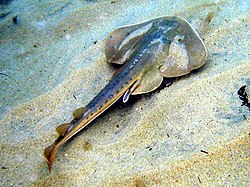| Platyrhinidae Temporal range: | |
|---|---|
 | |
| Fanray (Platyrhina sinensis) | |
 | |
| Thornback guitarfish (Platyrhinoidis triseriata) | |
| Scientific classification | |
| Domain: | Eukaryota |
| Kingdom: | Animalia |
| Phylum: | Chordata |
| Class: | Chondrichthyes |
| Subclass: | Elasmobranchii |
| Order: | Torpediniformes |
| Family: | Platyrhinidae D. S. Jordan, 1923 |
The Platyrhinidae are a family of rays, commonly known as thornbacks due to their dorsal rows of large thorns. They resemble guitarfishes in shape. Though traditionally classified with stingrays, molecular evidence suggests they are more closely related to electric rays in the order Torpediniformes. [1]
The earliest fossil member of this family is Tingitanius from the Late Cretaceous (Turonian) of the Akrabou Formation in Morocco, known from a three-dimensionally preserved juvenile specimen. Tingitanius is thought to be the sister genus to Platyrhinoidis . Stem-members of this family also known from fossil remains are Britobatos from the Santonian of Sahel Alma, Lebanon, Tethybatis from the Campanian/Maastrichtian of Nardo, Italy, and Eoplatyrhina from the Ypresian of Monte Bolca, Italy. [2] [3]